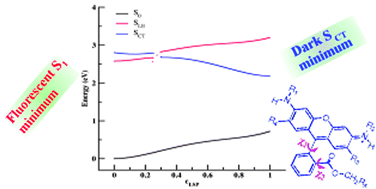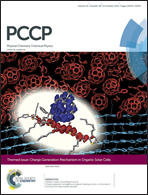Non-radiative decay paths in rhodamines: new theoretical insights†
Abstract
We individuate a photoinduced electron transfer (PeT) as a quenching mechanism affecting rhodamine B photophysics in solvent. The PeT involves an electron transfer from the carboxylate group to the xanthene ring of rhodamine B. This is finely modulated by the subtle balance of coulombic and non-classical interactions between the carboxyphenyl and xanthene rings, also mediated by the solvent. We propose the use of an electronic density based index, the so called DCT index, as a new tool to assess and quantify the nature of the excited states involved in non-radiative decays near the region of their intersection. In the present case, this analysis allows us to gain insight on the interconversion process from the bright state to the dark state responsible for the quenching of rhodamine B fluorescence. Our findings encourage the use of density based indices to study the processes affecting excited state reactions that are characterized by a drastic change in the excitation nature, in order to rationalize the photophysical behavior of complex molecular systems.


 Please wait while we load your content...
Please wait while we load your content...